|
The Neapolitan Nativity Scene:
The High Art of Life
By Mike McLeod
Posted December 2015

St. Francis of Assisi (born Giovanni di Pietro di Bernardone and nicknamed “Francesco”) is believed to be the first person to recreate the Nativity with a manger scene and live animals in about 1223. It is said he did this so the townspeople and those of his Franciscan order could experience the humble circumstances of the Christ Child’s birth.
The tradition of the live Nativity scene grew out of this, and it has been recreated the world over since then. The “non-live” manger scene with character and animal figures, also known as a crèche (“crib,” pronounced “kresh”), are known in every Christian culture and probably can be attributed to the inspiration of St. Francis.
|
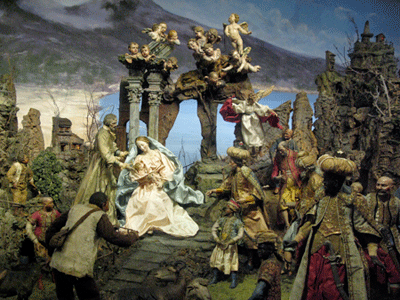
This 18th-century Neapolitan crèche is thought to have been created as a gift to Victor Amadeus II, King of Sardinia, on the occasion of his coronation in 1720. It is on permanent display at the Abbey of Regina Laudis at 273 Flanders Rd, Bethlehem, Conn. (Photo by Joan V. Cullman and courtesy of the Abbey of Regina Laudis, abbeyofreginalaudis.org.)
|
In the centuries following St. Francis’ the Nativity, cottage industries grew up in many countries creating crèches. In Naples, Italy, the industry took hold with a religious fervor, and the crèche was raised to a level of high art. Known as Neapolitan (that is, “of Naples”) presepios, (“cribs” in Italian), these early nativities moved the traditional setting from a humble stable to a bustling village of the 1700s. Neapolitan presepios also expanded the usual characters from the Holy Family, the Three Wise Men, angels, and shepherds to include all of the townspeople and occupations found in a village, from fishmongers and peddlers to drunkards and beggars. It also set them in their usual surroundings: workshops, taverns, homes, markets, streets and even the ruins of pagan temples.
The attention to detail in the features and 18th century costumes of Neapolitan figures is astounding, right down to the buttons on jackets, the knuckles on fingers, glass eyes and accessories galore—necklaces, earrings, lace on cuffs, embroidery on dresses and coats, and so on. If that was not sufficient to amaze, Neapolitan presepios also feature a menagerie of animals, miniature tools of the trades, bottles, cups, wares of vendors like fruit, vegetables, bread and so on. All to represent daily life continuing its course while few witness the miracle of the Virgin Birth.
|
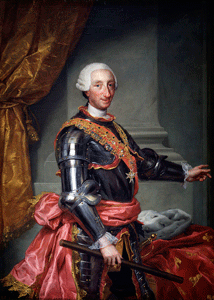
|
Charles III of Spain by Anton Raphael Mengs (1728-1779), a major collector of crèches.
|
The Golden Age of the Neapolitan crèche occurred during the reign of Charles I, who later reigned in Spain as King Charles III. In the 1700s, Spain ruled much of Italy; however, the Kingdom of Naples was claimed by Austria. In 1734, Spanish forces under 18-year-old (and inexperienced) Charles I conquered the kingdoms of Sicily and Naples.
During the next 19 years of his rule there, Charles became a fervent collector of crèches, hiring sculptors and artists to create highly detailed characters and accoutrements for them. Female members of the court also became intrigued and sewed costumes for the figures. It is reported that Charles’ collection numbered more than 6,000 figures.
|
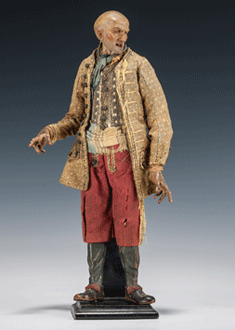
|
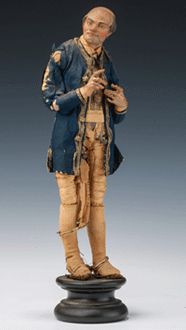
|
|
A Neapolitan crèche figure, late 18th or early 19th c., in original clothes. The head is of painted terracotta with glass eyes; the carved hands and lower legs are painted wood, 10.5 inches high. Offered for ₤1500 by Walpoles of London. (Photo: WalpoleAntiques.com.)
|
A ragged Neapolitan crèche figure, late 18th or early 19th c., original clothes in tatters, 10 inches high; offered for £ 750 by Walpoles of London. (Photo: WalpoleAntiques.com.)
|
The king’s passion for the crèche soon spread to other nobles in his court and the wealthy. They all became avid collectors and invited one another to view their ever-growing and intricate nativity scenes. The passion for presepios spread to the churches, town administrators and even to peasants. They all purchased or created their own crèches, and many invited friends and neighbors to come and behold. Elaborate crèches displayed by towns, cities and churches became an anticipated seasonal attraction with many vying to outdo one another. Modern crèche competitions continue around the world today.
|
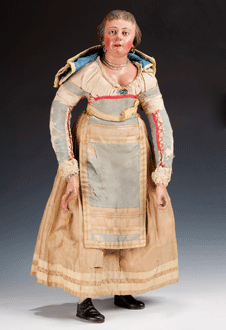
|
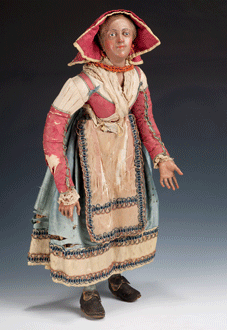
|
|
A Neapolitan woman figure of polychromed terracotta and carved wood, late 18th or early 19th c., dressed in the original silk and cotton clothing with lace cuffs, necklace and matching earrings; 19.5 inches high; £ 2,950, Walpoles of London.
(Photo: WalpoleAntiques.com.)
|
A polychromed terracotta and carved wood figure, late 18th or early 19th c., dressed in the original silk and cotton clothing with lace cuffs and laced sleeve overlays, a red necklace and matching earrings;18.75 inches high; £1950, Walpoles of London.
(Photo: WalpoleAntiques.com.)
|
Crèche figures have been made of wood, wood pulp, terra cotta, tow (flax or grasses), wax, and later, wire to make the arms, legs and bodies posable. Character features are often polychrome, and fine examples have hand-blown glass eyes. Figures from the 18th century can be found standing from 10 inches high to more than 20 inches. Due to the age of the materials, the intricate clothing of the townspeople and the exotic costumes of the Magi (with turbans, bejeweled robes, and billowy pantaloons) are usually very fragile, of course.
Painted backgrounds were sometimes used to set the scene, but often, the focus of the Nativity was a cave carved from cork. The rubble of a pagan temple is another popular background, which was symbolic of Christianity overcoming pagan Rome and paganism in general.
|
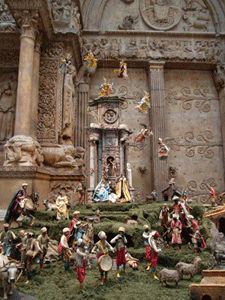
|
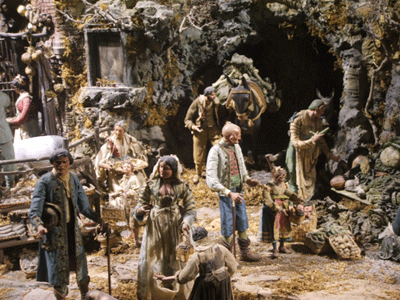
|
|
A Neapolitan presepio at the Carnegie Museum of Art. (Photo: Pschemp.)
|
A Neapolitan presepio showing a market scene from the Royal Caserta Palace of Charles III, second half of 18th c., made from terracotta, tow, wire and cork. (Photo: Twice25 & Rinina25.)
|
Entire crèche displays almost never come to auction; they are usually bequeathed to heirs or donated to museums. However, individual figures or groups sometimes do. Values of individual Neapolitan characters vary, and those from the 1700s have sold in the range of from approximately $1,000 or $2,000 up to about $10,000. Crèche figures often sell in lots of several figures. In 2004, Sotheby’s New York sold a group of 13 crèche figures from the 18th century for $31,200.
Early Neapolitan presepios or crèches are a snapshot in time of life in the 17th or 18th centuries. Large displays are sometimes put on display by museums, and an opportunity to view one should not be missed. The Art Institute of Chicago (www.artic.edu) features an annual display of 200 figures which includes 50 animals and 41 representations of food and drink. The New York Metropolitan Museum of Art’s (metmuseum.org) annual “Christmas Tree and Neapolitan Baroque Crèche” has 55 angels, 22 cherubs, 69 Nativity figures (including the Holy Family, Magi, shepherds, flocks and townspeople) and 50 animals.
Whether witnessed in person or on the Internet, Neapolitan crèches are to be adored.
------------------------------------------
Credit:
“History and Tradition of the Crèche,” www.presepi.it.
|